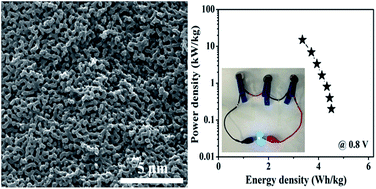Three-dimensional freestanding hierarchically porous carbon materials as binder-free electrodes for supercapacitors: high capacitive property and long-term cycling stability†
Abstract
Recently, hierarchically porous carbon materials with advantages of hierarchical porosity and large specific surface areas exhibiting desirable capacitive performance have been widely investigated. Herein, a facile and template-free phase separation methodology has been presented to prepare three-dimensional freestanding hierarchically porous carbon (HPC) materials. Importantly, the as-fabricated HPC with highly uniform and well-interconnected pores can afford plentiful transport channels for rapid diffusion of more ions, and the highly conductive cross-linked backbones ensure fast electron transfer, both of which can greatly reduce the internal resistance and improve the electrochemical properties. As expected, the as-fabricated HPC-based supercapacitor has achieved outstanding electrochemical performance with a high cell capacitance of 51 F g−1 at a current density of 0.5 A g−1, good rate capability with 75% capacitance retention of initial capacitance at 32 A g−1 as well as a maximum energy density of 4.5 W h kg−1 at 200 W kg−1 and a maximum power density of 15 100 W kg−1 at 3.4 W h kg−1. More significantly, a remarkable cycling stability almost without capacitance loss after the 50 000 charge/discharge test at 5 A g−1 has been achieved for the HPC-based supercapacitors. All these results suggest that the as-synthesized HPC has great potential for application not only as a supercapacitor electrode but also as a substrate for supporting capacitive materials.


 Please wait while we load your content...
Please wait while we load your content...